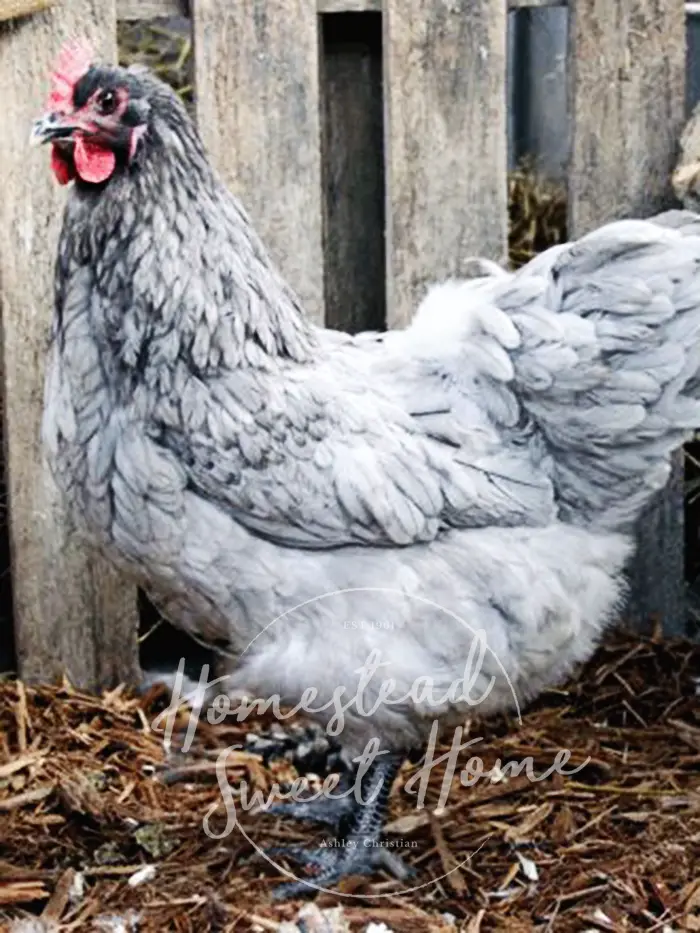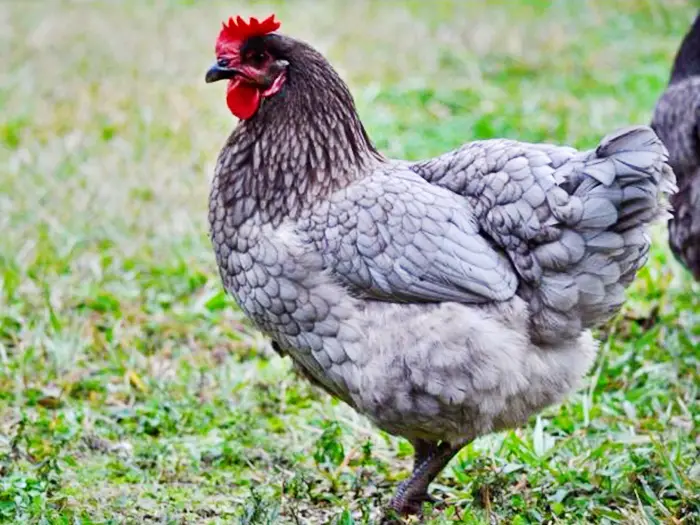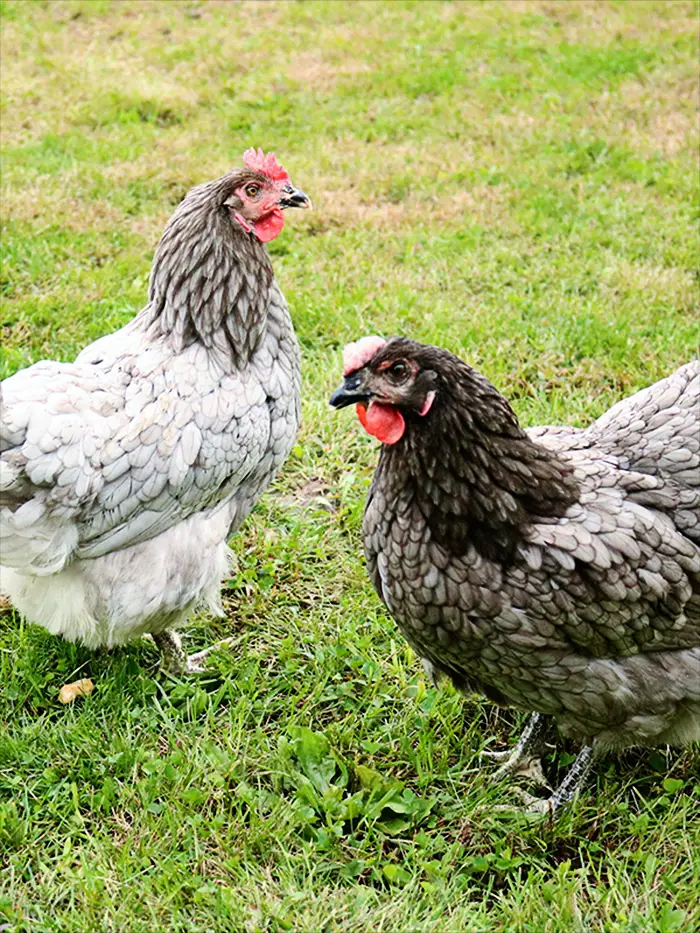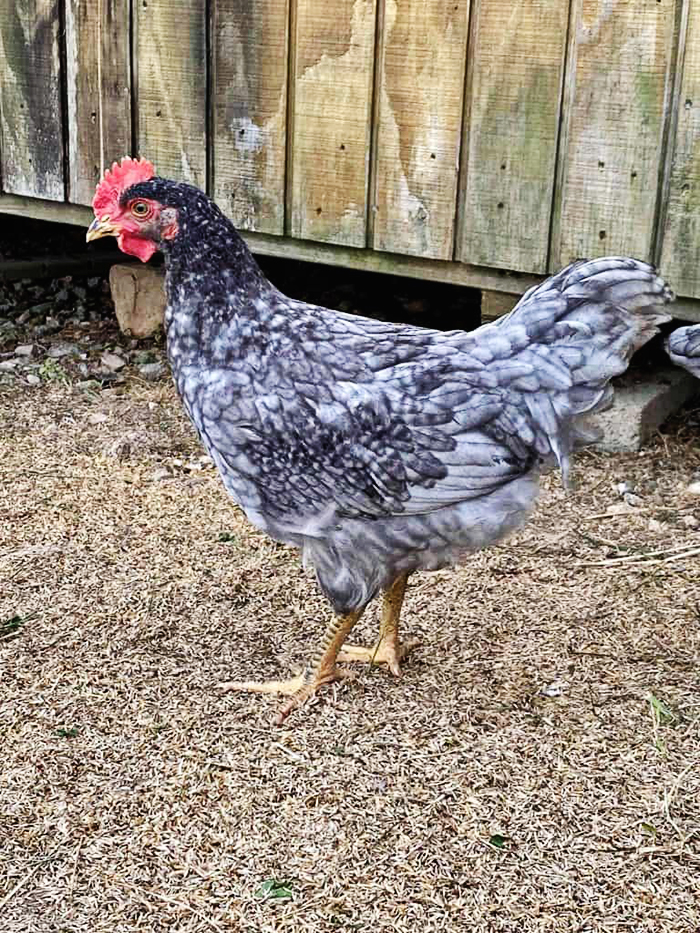Sapphire Gem Chickens – Blue Chickens that Lay 300 Eggs/ Year

Sapphire Gem Chicken Quick Facts
- Known for: greyish/blue and lavender-colored chickens that are excellent layers of big brown eggs, and can be easily sexed at birth
- Temperament: hardy, vibrant, fast-growing, friendly, sociable, and kind to other chickens
- Eggs: 300 large brown eggs each year
- Meat: good—reaches maturity at 20 weeks with 6 lb males and 5 lb females
- Climate: good heat and cold tolerance
- Broodiness: not very likely to sit on their eggs
Sapphire Gem Chicken Overview
The Sapphire Gem chicken is a cross between a Blue Plymouth Rock and a Barred Plymouth Rock and originated in the Czech Republic. Since it’s not a breed officially accepted into the American Poultry Association, Hoover’s Hatchery has trademarked the name “Sapphire Gem”, so you will see it also called the Sapphire Blue Plymouth Rock, the Blue Sapphire, or other similar names.
Sapphire Gem chickens are prized for their beautiful light blue feather coloring and their excellent egg-laying abilities. These chickens can lay up to 300 eggs per year, which is one of the most prolific egg-laying breeds, rivaling the Rhode Island Red’s 250 eggs per year.
Sapphire Gem chickens have sweet dispositions and are friendly birds. They are known to get along well with other flock members. They are surprisingly hardy and fast-growing too.
Pros and Cons of Sapphire Gem Chickens
- Pros: beautiful light blue feathering, top-notch layers of big brown eggs, friendly and calm, hardy, can be sexed easily at hatching, and are good foragers
- Cons: can be more difficult to find, are hybrids so they won’t breed true meaning a mating of Sapphire Gem chickens won’t produce true Sapphire Gem chicks
Sapphire Gem Chicken Appearance
- Size: medium-sized birds 5 lb females and 6 lb males
- Colors: what is referred to as blue in the poultry industry, is really more a light bluish/grey or light lavender color, but they are truly stunning
- Egg Color: large brown eggs
Sapphire Gems are sex-link chickens because the hybrid cross of two other breeds of chicken will result in male and female offspring that are easily recognizable from each other. A male will have blue feathers with a white dot on his head, and a female will have blue feathers with a ring of gold or grey around her neck.

Sapphire Gem Chicken Egg Production
The Sapphire gem is one of the most prolific egg-laying hybrid breeds you can find. Very few other breeds will lay as much as they do, which is a real benefit. They are very cold hardy and rarely go broody so these traits help make them excellent egg layers that hardly take breaks, even through winter.
Sapphire Gem chickens are a fast-growing hybrid breed that reaches sexual maturity at 20 weeks and may begin to lay soon after. Because the Sapphire gem chicken lays so many eggs, you’ll want to give her supplemental calcium to keep her healthy.
Offer a separate bowl of oyster shells or crushed eggshells to consume as desired. These supplements will provide the extra calcium they require to lay eggs as well as possible. Their layer feed does have added calcium, but it is often not enough. Chickens will naturally regulate their own calcium intake, and either too much or too little can be harmful, so you don’t want to mix it in their regular feed but offer it separately.
Sapphire Gem Chicken Meat Production
The Sapphire Gem chicken can certainly be used for meat, but the dressed birds will be small and nothing compared to other dual-purpose or hybrid meat birds. The main reason you’d want to butcher Sapphire Gem chickens is to cull unwanted roosters.
These chickens are fast growers and will reach maturity around 20 weeks when you can butcher them. Or you can also let them continue growing to get the most meat possible and butcher at 7 to 8 months old. After around 9 to 10 months, your chickens will become less tender and will be best used as stew meat or chicken stock.

Sapphire Gem Chicken Broodiness
Sapphire Gem chickens very rarely go broody. If you want to hatch fertilized Sapphire Gem chicken eggs yourself, you can purchase an incubator that automatically turns your eggs, and controls the temperature and some models even control the humidity. There is nothing quite as special as watching chicks hatch! If you have a broody hen from another breed or a Silkie chicken, you can always slip some eggs under her.
Do remember that if you hatch fertilized Sapphire gem chicken eggs, the offspring won’t breed true since it’s a hybrid bird. You can always try and see what patterns you get.
Sapphire Gem Chicken Temperament
Sapphire Gem chickens are docile and friendly. They get along well with their flock mates and make excellent pets for children. They are sweet and cuddly, especially when they’ve been raised since they were chicks.
Sapphire gem chickens are alert and aware of predators and make excellent foragers. You’ll want to give your Sapphire gem chickens ample space in the run, supervised free-range time, or if that’s not possible they would love using a chicken tractor that can be moved to new pasture or grass every few days.
Sapphire Gem chickens are very sociable and will love to follow you around and “talk” to you. They also enjoy being held, cuddled, and will even fall asleep in your arms.
Sapphire Gem Chicken Noise Level
Because the Sapphire Gem chicken is a calm and docile breed, they tend to also be quiet. This makes them an excellent choice in a neighborhood as long as they have plenty of space in the run or to roam the backyard. All chickens will sing an “egg-laying song” and alert for predators, but in general, they tend to be quiet.

Sapphire Gem Chicken Care
Sapphire Gem chickens are thankfully hardy and free of disease or breed problems. Their predator savviness can help them outlive other chicken breeds.
As with all chickens, you will want to keep the coop and run clean and free of manure build-up and soiled bedding. Get your chicks vaccinated or use medicated chick starter, and put a few teaspoons of apple cider vinegar in their plastic waterer to boost their immune systems.
Because the Sapphire Gem chicken is an active breed that loves to forage, they will do well with space to free-range. You can do this with an extra-large enclosed run, supervised free-range time, or using a chicken tractor to move them from place to place.
To learn more about how to take care of your Sapphire Gem chickens, read our Ultimate Guide to Taking Care of Chickens.
Sapphire Gem Chicken Housing
Sapphire gem chickens need four square feet each inside their coop, and fifteen square feet each in their run. Ideally, you will free-range your Sapphire gem chickens. If you aren’t able to let them freely forage, an extra-large run or a chicken tractor would be best.
Provide a roost in the coop for your chickens at night as Sapphires can fly well and will love to roost up high. Your hens will need about one nesting box for every three hens so they don’t get too crowded and their nesting boxes should be about 12×12.
To help encourage your Sapphire Gem chickens in their excellent egg-lay abilities, provide at least one window in their coop, preferably more. Chickens need 16 hours of daylight to lay efficiently, so allowing plenty of light into the coop even through the winter months will encourage this amazing ability to lay so well. If you live in a climate with very short winter days, you may even consider adding a light on a timer inside the coop that stays on 16 hours in the day and turns off at night.
Feeding Sapphire Gem Chickens
Sapphire Gem chickens can be given standard chick starter from hatching till they reach maturity around 20 weeks. Layer feed contains 16% protein and added calcium to keep their eggshells healthy and strong. You’ll also want to offer a separate container of supplemental calcium in the form of oyster shells or crushed-up eggshells. Roosters can eat the same feed as the hens unless you plan to butcher them, then you may want to give them a higher protein feed.
If you plan to vaccinate your chicks, you can give them unmedicated chick starter. If you don’t vaccine them, you’ll want to give them medicated chick starter to keep them from contracting coccidiosis.
You should give your Sapphire Gem chickens as much free-roaming space to eat plants and bugs as you can provide. They’ll also enjoy kitchen scraps (though there are some that are harmful, so avoid avocados, dried beans, junk or rotten food, green potato skins, citrus, onions, or tomato or potato leaves from the garden.) Giving them this variety will not only help you save money on the feed but will also keep them healthy and entertained.
Offering confined Sapphire Gem chickens grit is important for their health. Since chickens don’t have teeth, they need fine gravel or coarse sand in their gizzards to digest their food. Free-range chickens can usually naturally find this, but if your Sapphire Gem chickens don’t have access to pebbles, sand, or fine gravel, you’ll want to offer some supplemental grit.
Chicken Treats: You don’t HAVE to give your Sapphire Gem chickens treats, but it’s a lot of fun! Mealworm and black soldier fly larva treats are excellent snacks for chickens that you can get from the feed store.
What is it like to own a Sapphire Gem Chicken?
Sapphire Gem chickens are a delight to everyone who owns them. While many breeds have strong points with corresponding weak points, the Sapphire Gem seems to be the perfect mix.
They are friendly, calm, docile, and kind to their flock mates while still being alert and good at watching for predators. These two personality traits existing in one chicken is fairly uncommon. They are usually good at either one or the other, but the Sapphire Gem possesses both qualities.
Sapphire Gem chickens really shine as egg-layers. They can consistently and regularly produce more eggs each year than nearly any other breed—an incredible 300 eggs per year. Their cold hardiness helps them lay through the winter, and their lack of broodiness ensures they won’t take long breaks to brood on a clutch of eggs.
Another wonderful feature of the Sapphire Gem chicken is its beautiful grey/lavender/blue-colored feathers. Their ability to be sexed at birth can also be very helpful if you plan to cull the extra roosters in your flock and feed them broiler feed separately to prepare for butchering. About one rooster for every 8 hens will do, so you’ll want to make a plan for your extra roosters if you buy chicks in a straight run mixed with males and females.
For example, let’s say you order 16 unsexed chicks and end up with about half and half of each gender. You can then separate the boys from the girls, and raise your boys on broiler feed to help them gain weight for butchering. As you observe your chicks, pick out the boy with the best personality and place him with your girls to raise together.
Sapphire Gem Chicken Breed History
Sapphire Gem chickens are a hybrid cross between a Blue Plymouth Rock and a Barred Plymouth Rock chicken. They are a hybrid and not a true breed meaning their offspring won’t produce consistent traits.
They are bred very close to the old Andalusian chickens of Spain, that have long been in England and America. Since they are not a true breed, they have not been accepted into APA (American Poultry Association.)
Hoover’s Hatchery has trademarked the name Sapphire Gem, so other hatcheries will call these birds by different names so you’ll have to read the hatchery’s description closely. Don’t hesitate to call your hatchery and ask questions if needed.
Summary
If you’re looking for an excellent egg-laying chicken in a beautiful blue/lavender color, there is none better than the Sapphire Gem chicken. You won’t be disappointed with the calm, friendly personality, how well it gets along with its flock mates, and its ability to stay alert and watch out for predators.
Do you own Sapphire Gem chickens? What would you do with hundreds of farm-fresh eggs each year? Let us know in the comments below what your experience has been.

One Comment
I am interested in purchasing 4 pullets where are you located? I live one hour south of Toledo, OH.